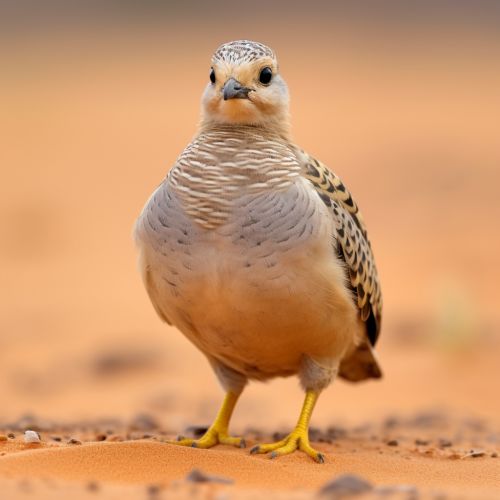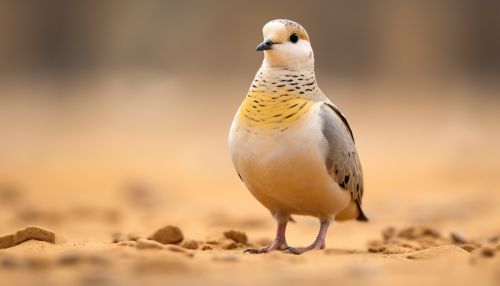Sandgrouse
Taxonomy and Evolution
Sandgrouse are birds in the order Pteroclidae, which is a small group of species adapted to arid environments. The order is divided into two families: Pteroclidae (sandgrouse) and Syrrhaptes (Pallas's Sandgrouse and Tibetan Sandgrouse). These birds are believed to have evolved during the Miocene epoch, around 20 million years ago, in the regions of North Africa and the Middle East.


Physical Characteristics
Sandgrouse have compact bodies, short legs, and long pointed wings. They are sexually dimorphic, with males typically having more vibrant plumage than females. Their feathers are intricately patterned and colored to resemble the environment, providing excellent camouflage. The birds' feet are adapted for walking on sand, with thick, scaled skin that protects them from the hot ground. Their toes are short and stout, lacking the hind toe that most birds possess.
Distribution and Habitat
Sandgrouse are found across the globe, from the deserts of North Africa and the Middle East to the arid regions of India and Mongolia. They inhabit a variety of habitats, including deserts, semi-deserts, and steppes. These birds are highly adapted to their arid environments, with physiological and behavioral adaptations that allow them to survive in these harsh conditions.
Diet and Feeding Behavior
Sandgrouse primarily feed on seeds, which they find on the ground. They have a unique feeding behavior, in which they fill their crop with seeds in the morning and then return to their nest to digest them throughout the day. They are also known to consume small amounts of green vegetation and insects, particularly during the breeding season.
Reproduction and Life Cycle
The breeding season of sandgrouse varies depending on the region and the availability of food and water. Males perform elaborate courtship displays to attract females. The female lays two to three eggs in a simple nest on the ground. Both parents share the responsibility of incubating the eggs, which hatch after about 20-25 days. The chicks are precocial, meaning they are able to leave the nest and feed themselves shortly after hatching.
Adaptations
One of the most remarkable adaptations of sandgrouse is their ability to carry water back to their chicks in their feathers. The male bird soaks his belly feathers in water and then flies back to the nest, where the chicks drink from the soaked feathers. This adaptation allows sandgrouse to breed far from water sources, a crucial advantage in their arid habitats.
Conservation Status
While some species of sandgrouse are common and widespread, others are threatened by habitat loss, hunting, and climate change. Conservation efforts for these birds focus on protecting their habitats and regulating hunting.
Cultural Significance
In some cultures, sandgrouse are hunted for their meat and feathers. Their unique adaptations and behaviors have also made them a subject of interest in the field of ornithology.
